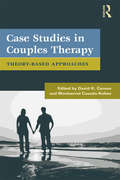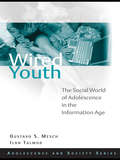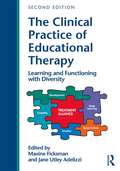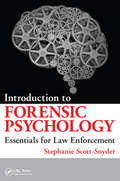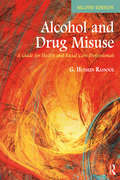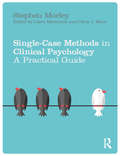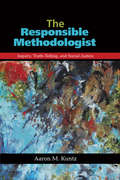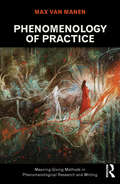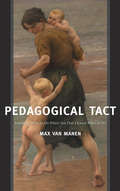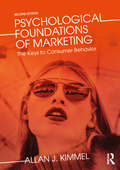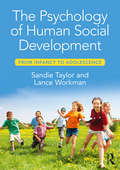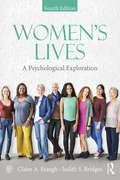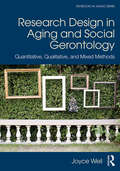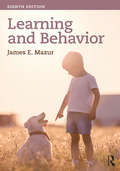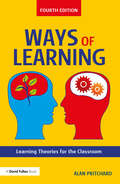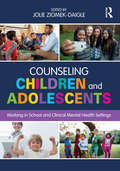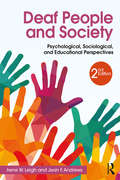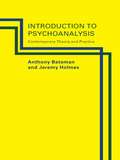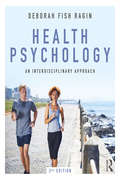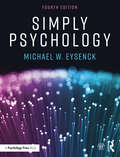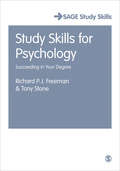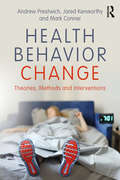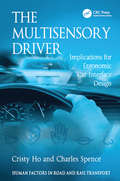- Table View
- List View
Case Studies in Couples Therapy: Theory-Based Approaches (Routledge Series on Family Therapy and Counseling)
by David K. Carson Montserrat Casado-KehoeThis up-to-date, highly readable, theory-based, and application-oriented book fills a crucial void in literature on couple therapy. Few books in the couple therapy market bridge the gap between theory and practice; texts tend to lean in one direction or the other, either emphasizing theory and research with little practical application, or taking a cookbook approach that describes specific techniques and interventions that are divorced from any conceptual or theoretical base. However, couples therapy requires a high degree of abstract/conceptual thinking, as well as ingenuity, inventiveness and skill on the part of the therapist. Case Studies in Couples Therapy blends the best of all worlds: clinical applications with challenging and diverse couples that have been derived from the most influential theories and models in couples and family therapy, all written by highly experienced and respected voices in the field. In Case Studies in Couples Therapy, readers will grasp the essentials of major theories and approaches in a few pages and then see how concepts and principles are applied in the work of well-known clinicians. The case studies incorporate a wide variety of couples from diverse backgrounds in a number of different life situations. It is simultaneously narrow (including specific processes and interventions applied with real clients) and broad (clearly outlining a broad array of theories and concepts) in scope, and the interventions in it are directly linked to theoretical perspectives in a clear and systematic way. Students and clinicians alike will find the theoretical overview sections of each chapter clear and easy to follow, and each chapter’s thorough descriptions of effective, practical interventions will give readers a strong sense of the connections between theory and practice.
Wired Youth: The Social World of Adolescence in the Information Age (Adolescence and Society)
by Gustavo Mesch Ilan TalmudThe debate on the social impact of information and communication technologies is particularly important for the study of adolescent life, because through their close association with friends and peers, adolescents develop life expectations, school aspirations, world views, and behaviors. This book presents an up-to-date review of the literature on youth sociability, relationship formation, and online communication, examining the way young people use the internet to construct or maintain their inter-personal relationships. Using a social network perspective, the book systematically explores the various effects of internet access and use on adolescents’ involvement in social, leisure and extracurricular activities, evaluating the arguments that suggest the internet is displacing other forms of social ties. The core of the book investigates the motivations for online relationship formation and the use of online communication for relationship maintenance. The final part of the book focuses on the consequences, both positive and negative, of the use of online communication, such as increased social capital and online bullying. Wired Youth is ideal for undergraduate and graduate students of adolescent psychology, youth studies, media studies and the psychology and sociology of interpersonal relationships.
Wired Youth: The Social World of Adolescence in the Information Age (Adolescence and Society)
by Gustavo Mesch Ilan TalmudThe debate on the social impact of information and communication technologies is particularly important for the study of adolescent life, because through their close association with friends and peers, adolescents develop life expectations, school aspirations, world views, and behaviors. This book presents an up-to-date review of the literature on youth sociability, relationship formation, and online communication, examining the way young people use the internet to construct or maintain their inter-personal relationships. Using a social network perspective, the book systematically explores the various effects of internet access and use on adolescents’ involvement in social, leisure and extracurricular activities, evaluating the arguments that suggest the internet is displacing other forms of social ties. The core of the book investigates the motivations for online relationship formation and the use of online communication for relationship maintenance. The final part of the book focuses on the consequences, both positive and negative, of the use of online communication, such as increased social capital and online bullying. Wired Youth is ideal for undergraduate and graduate students of adolescent psychology, youth studies, media studies and the psychology and sociology of interpersonal relationships.
The Clinical Practice of Educational Therapy: Learning and Functioning with Diversity
by Maxine Ficksman Jane Utley AdelizziDespite the wide array of services offered to students with learning disabilities, attention-deficit disorder, and a variety of comorbid conditions, large numbers of students are caught in the struggle of surviving school. Unfortunate school experiences may impact their sense of self and the degree of tenacity with which they pursue further training or challenging opportunities in the workplace. These are the people for whom educational therapy provides relief, enlightenment, and the coveted prize of success. The second edition of The Clinical Practice of Educational Therapy, the first textbook in its field, provides a comprehensive perspective of this interdisciplinary profession and practice, reaching out to a more global audience. The book describes the scope and practice of educational therapy from its European roots to its growing presence in the United States, providing readers with case studies and research that illustrate the work of educational therapists across the lifespan in diverse settings. Interdisciplinary Perspective — Other books focus on either educational or therapeutic interventions but rarely discuss the blend and synergy of disciplines (e.g., special education, neuropsychology, assessment, and social work) that are the hallmark of this unique profession. Illustrative Cases — The text draws heavily on case studies as a means of understanding the practice of educational therapy, especially the dynamic relationship that exists between therapist and client. Numerous charts and tables provide visuals for educational therapists as well as allied professionals, parents, and those with learning challenges. Expertise — The editors are both highly visible educational therapists. Chapter authors are either experienced educational therapists or allied professionals who have made scholarly contributions to the profession, such as Trisha Waters, Roslyn Arnold, and George McCloskey. In addition to benefiting educational therapists and students, this book is appropriate for professionals who work in related fields such as special education, regular education, school and educational psychology, neuropsychology, school counseling, psychology, speech and language pathology, art therapy, occupational therapy, and social work, as well as in medicine and psychiatry. NEW TO THE SECOND EDITION The second edition of The Clinical Practice of Educational Therapy: Learning & Functioning with Diversity has revised and updated the chapters from the first edition, and added three new chapters which further define and broaden this field by exploring diverse perspectives: Chapter 10, "Cultivating Character Development: Educational Therapy’s Impact on Individuals, Families, Schools, Educational Policy, and Society" by Maxine Ficksman Chapter 12, "Women and Girls Who Are Disenfranchised: A Global and Interdisciplinary Approach to Educational Therapy" by Jane Utley Adelizzi Chapter 17, "Examining the Efficacy of Graduate Programs in Educational Therapy at California State University, Northridge (CSUN): Educational Therapy Intern, Graduate and Parent Perspectives" by Marcy Dann, Nancy Burstein, Tamarah Ashton, and Sue Sears. These additional chapters, supported by brain-based research, characterize the shifts and changes experienced in a range of settings. Through the treatment alliance, educational therapists address students’ and clients’ ability to experience a more comprehensive model of learning, dependent upon the psychological, social, emotional, cultural and academic environments. The three new chapters range in focus from formal research and graduate training in the field of educational therapy to students throughout the lifespan whose social and educational experiences require a careful eye to not only the academic task at hand but also to the ways in which they cope and adapt to a range of environments and challenges. Lastly, educational therapy’s empathic foundation in practice is exemplified when we consider the global experience of students who strive to learn in situations and settings that threaten their survival a
Introduction to Forensic Psychology: Essentials for Law Enforcement
by Stephanie Scott-SnyderResearch indicates that there are psychological principles at play in the situations encountered by law enforcement personnel. The book fulfills an important need in the ever-evolving field of criminal justice, providing a working knowledge of forensic psychology and its application to interview strategies, homicide, emotional disturbance, sexual and domestic violence, hostage negotiations, and other situations. It will help law enforcement to understand, interpret, and anticipate behavior, while responding safely and effectively.
Alcohol and Drug Misuse: A Guide for Health and Social Care Professionals
by G. Hussein RassoolWritten by an experienced academic author, lecturer and practitioner, this comprehensive textbook provides an introduction to alcohol and drug misuse. It presents: the context of alcohol and drug misuse, and the nature and theories of addiction, including a historical overview and policy initiatives in contemporary society an overview of the problems associated with psychoactive substances and their impact on groups such as culturally and linguistically diverse communities, young people, women, older people and the homeless an understanding of the generic role responses to substance misuse in a variety of different settings and contexts, including primary care, the community and hospitals a framework for assessment, care planning, harm reduction approaches, dealing with overdose, intoxication and withdrawals, and psychological and pharmacological interventions an accessible and skills-oriented approach to assist students and practitioners in dealing with alcohol and drug misuse. This new edition is fully updated and includes new material on: evidence-based pharmacological interventions; recent global strategies in alcohol and drug; dual diagnosis and women; shisha smoking; and current statistics on prevalence of alcohol and drug misuse Alcohol and Drug Misuse takes into account current policy and practice for substance use and misuse and includes a range of pedagogical features to enhance learning. It is essential reading for nursing, health and social work students taking substance misuse modules, as well as related CPD courses for health and social care professionals.
Single Case Methods in Clinical Psychology: A Practical Guide
by Stephen MorleySingle-Case Methods in Clinical Psychology: A Practical Guide provides a concise and easily-accessible introduction to single-case research. This is a timely response to the increasing awareness of the need to look beyond randomised controlled trials for evidence to support best practice in applied psychology. The book covers the issues of design, the reliability and validity of measurement, and provides guidance on how to analyse single-case data using both visual and statistical methods. Single-case designs can be used to investigate an individual’s response to psychological intervention, as well as to contribute to larger scale research projects. This book illuminates the common principles behind these uses. It describes how standardised measures can be used to evaluate change in an individual and how to develop idiographic measures that are tailored to the needs of an individual. The issue of replication and generalising beyond an individual are examined, and the book also includes a section on the meta-analysis of single-case data. The critical evaluation of single-case research is examined, from both the perspective of developing quality standards to evaluate research and maintaining a critical distance in reviewing one’s own work. Single Case Methods in Clinical Psychology will provide invaluable guidance to postgraduate psychologists training to enter the professions of clinical, health and counselling psychology and is likely to become a core text on many courses. It will also appeal to clinicians seeking to answer questions about the effectiveness of therapy in individual cases and who wish to use the method to further the evidence-base for specific psychological interventions.
The Responsible Methodologist: Inquiry, Truth-Telling, and Social Justice
by Aaron M. KuntzWinner of The University of Alabama 2017 President’s Faculty Research Award What does it mean to be a responsible methodologist? Certainly it is more than being a research middle-manager who ensures that the tools used in a thesis or dissertation are of the right gauge. In The Responsible Methodologist, leading education scholar Aaron Kuntz uses the latest movements in social theory to challenge qualitative researchers to reconceptualize their work away from the technocratic toward an intervention, an ethical disruption of the norm, an activist stance toward progressive social change. Inviting creativity and vision, he insists that the responsible methodologist become a force leading the discourse toward social justice. His book-challenges the technocratic role given to qualitative methodologists in university settings;-urges them to become a force for change through Foucault’s parrhesia, risky truth-telling;-includes research projects that have incorporated this vision. http://amkuntz.people.ua.edu/
Phenomenology of Practice: Meaning-Giving Methods in Phenomenological Research and Writing (Developing Qualitative Inquiry)
by Max Van ManenMax van Manen offers an extensive exploration of phenomenological traditions and methods for the human sciences. It is his first comprehensive statement of phenomenological thought and research in over a decade. Phenomenology of practice refers to the meaning and practice of phenomenology in professional contexts such as psychology, education, and health care, as well as to the practice of phenomenological methods in contexts of everyday living. Van Manen presents a detailed description of key phenomenological ideas as they have evolved over the past century; he then thoughtfully works through the methodological issues of phenomenological reflection, empirical methods, and writing that a phenomenology of practice offers to the researcher. Van Manen’s comprehensive work will be of great interest to all concerned with the interrelationship between being and acting in human sciences research and in everyday life. Max van Manen is the editor of the series Phenomenology of Practice, https://www.routledge.com/series/PPVM
Pedagogical Tact: Knowing What to Do When You Don’t Know What to Do (Phenomenology of Practice)
by Max Van ManenPedagogical Tact describes how teacher-student relations possess an improvisational and ethical character. The daily realities of educators, parents, and childcare specialists are pedagogically conditioned by sensitive insights, active thoughtfulness, and the creative ability to act caringly and appropriately in the immediacy of the moment. Internationally known educator Max van Manen shows through recognizable examples and evocative stories how good teaching is driven by the phenomenology of pedagogy. His book-refocuses educators and others away from an emphasis on instrumental skills and technocratic programs toward the need for pedagogical tact;-describes how pedagogical actions have latent effects that will influence children throughout their lives;-shows how our actions with young people have pedagogically ethical and moral significance;-gives educators back their original vocational motivation and inspiration.
Psychological Foundations of Marketing: The Keys to Consumer Behavior
by Allan J KimmelThis is the only textbook to provide an applied, critical introduction to the role of psychology in marketing, branding and consumer behavior. Ideally suited for both students and professionals, the new edition is a complete primer on how psychology informs and explains marketing strategies, and how consumers respond to them. The book provides comprehensive coverage of: Motivation: the human needs at the root of many consumer behaviors and marketing decisions. Perception: the nature of perceptual selection, attention, and organization and how they relate to the evolving marketing landscape. Decision making: how and under what circumstances it is possible to predict consumer choices, attitudes, and persuasion. Personality and lifestyle: how insight into consumer personality can be used to formulate marketing plans. Social behavior: the powerful role of social influence on consumption. Now featuring case studies throughout to highlight how psychological research can be applied in the marketplace, and insightful analysis of the role of digital media and new technologies, this award-winning textbook is required reading for anyone interested in this fascinating and evolving subject.
The Psychology of Human Social Development: From Infancy to Adolescence
by Sandie Taylor Lance WorkmanThe Psychology of Human Social Development provides a comprehensive introduction to the essential core topics and exciting new findings in this thriving field of developmental psychology. Following a thematic approach, the book looks at key topics in social development in childhood and adolescence, including personality development and research methods, taking the reader from first principles to an advanced understanding. The book explores socio-emotional development and social learning, as well as the history of thinking, and the evolutionary roots of social development, whilst also providing a clear balance between nature and nurture approaches. Taylor and Workman’s user-friendly writing style accommodates readers with no previous knowledge of the subject area whilst exploring the most up-to-date theories and research from various areas of psychology which have gained relevance to developmental psychology. Featuring student-friendly pedagogy throughout, including end-of-chapter summaries, further reading recommendations and questions for discussion, The Psychology of Human Social Development is essential reading for undergraduates on social development or developmental psychology courses and relevant for related fields such as education, gender studies and nursing.
Women's Lives: A Psychological Exploration, Fourth Edition
by Claire A. Etaugh Judith S. BridgesThis cutting-edge and comprehensive fourth edition of Women’s Lives: A Psychological Perspective integrates the most current research and social issues to explore the psychological diversity of girls and women varying in age, ethnicity, social class, nationality, sexual orientation, and ableness. Written in an engaging and accessible manner, its use of vignettes, quotes, and numerous pedagogical tools effectively fosters students’ engagement, active learning, critical thinking, and social activism. New information covered includes: neoliberal feminism, standpoint theory, mujerista psychology (Chapter 1) LGBT individuals and individuals with disabilities in media (Chapter 2) testosterone testing of female athletes, precarious manhood (Chapter 3) raising a gender non-conforming child, impact of social media on body image (Chapter 4) gender differences in narcissism and Big Five personality traits, women video-game designers (Chapter 5) asexuality, transgender individuals, sexual agency, "Viagra for women" controversy (Chapter 6) adoption of frozen embryos controversy (Chapter 7) intensive mothering, integrated motherhood, "living apart together", same-sex marriage (Chapter 8) single-sex schooling controversy (Chapter 9) combat roles opened to U.S. women, managerial derailment (Chapter 10) work-hours dilemmas of low-wage workers (Chapter 11) feminist health care model, health care for transgender individuals, Affordable Care Act (Chapter 12) feminist critique of CDC guidelines on women and drinking (Chapter 13) cyberharassment, gendertrolling, campus sexual assault (Chapter 14) transnational feminism, men and feminism (Chapter 15) Women’s Lives stands apart from other texts on the psychology of women because it embeds within each topical chapter a lifespan approach and robust coverage of the impact of social, cultural, and economic factors in shaping women’s lives around the world. It provides extensive information on women with disabilities, middle-aged and older women, and women in transnational contexts. Its up-to-date coverage reflects current scientific and social developments, including over 2,200 new references. This edition also adds several new boxed features for student engagement. In The News boxes present current, often controversial, news items to get students thinking critically about real-life applications of course topics. Get Involved boxes encourage students to actively participate in the research process. What You Can Do boxes give students applied activities to promote a more egalitarian society. Learn About the Research boxes expose students to a variety of research methods and highlight the importance of diversity in research samples by including studies of underrepresented groups.
Research Design in Aging and Social Gerontology: Quantitative, Qualitative, and Mixed Methods (Textbooks in Aging)
by Joyce WeilResearch Design in Aging and Social Gerontology provides a review of methodological approaches and data-collection methods commonly used with older adults in real-life settings. It addresses the role of normative age-related sensory, cognitive, and functional changes, as well as the influence of generational cohort (age-period-cohort) upon each design. It discusses the role of older adults as true co-researchers; issues uniquely related to studies of persons residing in community-based, assisted, skilled, and memory-care settings; and ethical concerns related to cognitive status changes. The text concludes with detailed guidelines for improving existing data collection methods for older persons and selecting the best fitting methodologies for use in planning research on aging. Features of Research Design in Aging and Social Gerontology include: Descriptions and evaluations of a wide range of methodological approaches, and methods used to collect data about older persons (quantitative, qualitative, mixed, and emergent methods: photovoice, virtual environments, etc.) Ways to match research questions to selection of method without a preconceived methodological preference or dominance Real-world and applied examples along with cases from the gerontological literature "How to" sections about reading output/software reports and qualitative-analysis screenshots (from ATLAS.ti) and quantitative (SPSS) output and interpretation Pedagogical tools in every chapter such as text boxes, case studies, definitions of key terms, discussion questions, and references for further reading on chapter topics Glossary of key terms, complete sample research report, and an overview of past methodological research design work in gerontology Companion website at www.routledge.com/cw/Weil where instructors will find PowerPoint presentations, additional discussion questions, and a sample syllabus; and students will find flashcards based on glossary terms, a downloadable copy of the sample research report in the text, and links to data sets, related websites, further reading, and select gerontological journals This text is intended for upper-level undergraduates and masters students in aging and gerontology as well as students in human development, applied anthropology, psychology, public health, sociology, and social-work settings. Health care professionals, social workers, and care managers who work with older adults will also find this text a valuable resource.
Learning & Behavior: Eighth Edition
by James E. MazurThis book reviews how people and animals learn and how their behaviors are changed as a result of learning. It describes the most important principles, theories, controversies, and experiments that pertain to learning and behavior that are applicable to diverse species and different learning situations. Both classic studies and recent trends and developments are explored, providing a comprehensive survey of the field. Although the behavioral approach is emphasized, many cognitive theories are covered as well, along with a chapter on comparative cognition. Real-world examples and analogies make the concepts and theories more concrete and relevant to students. In addition, most chapters provide examples of how the principles covered have been applied in behavior modification and therapy. Thoroughly updated, each chapter features many new studies and references that reflect recent developments in the field. Learning objectives, bold-faced key terms, practice quizzes, a chapter summary, review questions, and a glossary are included. The volume is intended for undergraduate or graduate courses in psychology of learning, (human) learning, introduction to learning, learning processes, animal behavior, (principles of) learning and behavior, conditioning and learning, learning and motivation, experimental analysis of behavior, behaviorism, and behavior analysis. Highlights of the new edition include: -A new text design with more illustrations, photos, and tables. -In the Media, Spotlight on Research, and Applying the Research boxes that highlight recent applications of learning principles in psychology, education, sports, and the workplace. -Discussions of recent developments in the growing field of neuroscience. - Coverage of various theoretical perspectives to the study of learning—behavioral, cognitive, and physiological. - Expanded coverage of emerging topics such as the behavioral economics of addictions, disordered gambling, and impulsivity. -New examples, references, and research studies to ensure students are introduced to the latest developments in the field. - A website at www.routledge.com/9781138689947 where instructors will find a test bank, Powerpoint slides, and Internet links. Students will find practice questions, definitions of key terms, chapter outlines, and Internet sources for additional information.
Ways of Learning: Learning Theories for the Classroom
by Alan PritchardWhile most teachers are skilled in providing opportunities for the progression of children’s learning, it is sometimes without fully understanding the theory behind it. With greater insight into what is currently known about the processes of learning and about individual learners, teachers are better equipped to provide experiences and situations that are more likely to lead to effective acquisition of knowledge, concepts and skills. Ways of Learning has been widely used and now, fully updated, it seeks to provide further insight into the ways in which learning takes place, which teachers can make use of in their planning and teaching, including: ■ an overview of learning ■ behaviourism and the beginning of theory ■ cognitive and constructivist learning ■ multiple intelligences and learning styles ■ difficulties with learning ■ the influence of neuropsychology ■ other theories, philosophies and names ■ relating theory to practice. The fourth edition of this book includes developments in areas covered in the preceding editions, as well as expanding on certain topics to bring about a wider perspective; most notably, a new consideration of learning styles and a new chapter detailing important thinkers and writers from the history of education and their continuing influence along with other theories, ideas and thoughts not included in the rest of the book. The book also reflects changes in government policy and is closely related to new developments in practice. Written for trainee teachers, serving teachers and others interested in learning for various reasons, Ways of Learning serves as a valuable introduction for students setting out on higher degree work who are in need of an introduction to the topic.
Counseling Children and Adolescents: Working in School and Clinical Mental Health Settings
by Jolie Ziomek-DaigleCounseling Children and Adolescents gives students the information they need to prepare for work in both school and clinical mental health settings (two CACREP—Council for Accreditation of Counseling and Related Educational Programs—specialty areas). This text includes not only content related to developmental and counseling theories but also information on evidence-based practices across the continuum of care, diagnosis and treatment of youth, and current trends such as integrated care, mindfulness, and neuroscience. Unique to this book are sections on both the instructional and behavioral Response to Intervention (RtI) model and PBIS, examples of evidence-based practices used across settings such as Student Success Skills, Check & Connect, and trauma-focused CBT, and a review of common mental health-related disorders most often seen in youth and treatment recommendations. Ethical and legal implications are infused throughout the book, as are CACREP learning outcomes. Instructors using this textbook can also turn to its companion website to access test questions for each chapter. Expansive and practical, Counseling Children and Adolescents fills a gap in counselor preparation programs and provides an important resource that can be used across specialty areas and coursework.
Deaf People and Society: Psychological, Sociological and Educational Perspectives
by Irene W. Leigh Jean F. AndrewsDeaf People and Society incorporates multiple perspectives related to the topics of psychology, education, and sociology, including the viewpoints of deaf adults themselves. In doing so, it considers the implications of what it means to be deaf or hard of hearing and how deaf adults’ lives are impacted by decisions that professionals make, whether in the clinic, the school, or when working with family. This second edition has been thoroughly revised and offers current perspectives on the following topics: Etiologies of deafness and the identification process The role of auditory access Cognition, language, communication, and literacy Bilingual, bilingual/bimodal, and monolingual approaches to language learning Educational, legal, and placement aspects Childhood psychological issues Psychological and sociological viewpoints of deaf adults The criminal justice system and deaf people Psychodynamics of interaction between deaf and hearing people Each chapter begins with a set of objectives and concludes with suggested readings for further research. This edition contains 10 new and original case studies, including ones on hearing children of deaf adults, sudden hearing loss, a young deaf adult with mental illness, and more. Written by a seasoned deaf/hearing bilingual team, this unique text continues to be the go-to resource for students and future professionals interested in working with deaf and hard-of-hearing persons.
Introduction To Psychoanalysis: Contemporary Theory And Practice (PDF)
by Anthony Bateman Jeremy HolmesThe need for a concise, comprehensive guide to the main principles and practice of psychoanalysis and psychoanalytic psychotherapy has become pressing as the psychoanalytic movement has expanded and diversified. An introductory text suitable for a wide range of courses, this lively, widely referenced account presents the core features of contemporary psychoanalytic theory and practice in an easily assimilated, but thought-provoking manner. Illustrated throughout with clinical examples, it provides an up-to-date source of reference for a wider range of mental health professionals as well as those training in psychoanalysis, psychotherapy or counselling.
Introduction To Psychoanalysis: Contemporary Theory And Practice
by Anthony Bateman Jeremy HolmesThe need for a concise, comprehensive guide to the main principles and practice of psychoanalysis and psychoanalytic psychotherapy has become pressing as the psychoanalytic movement has expanded and diversified. An introductory text suitable for a wide range of courses, this lively, widely referenced account presents the core features of contemporary psychoanalytic theory and practice in an easily assimilated, but thought-provoking manner. Illustrated throughout with clinical examples, it provides an up-to-date source of reference for a wider range of mental health professionals as well as those training in psychoanalysis, psychotherapy or counselling.
Health Psychology: An Interdisciplinary Approach
by Deborah Fish RaginThis textbook takes a truly interdisciplinary approach to studying health psychology. It examines five systems that affect individual health outcomes: individual, family/community, social/physical environment, healthcare systems, and health policy. While grounded in psychology, it incorporates perspectives from anthropology, biology, economics, environmental studies, medicine, public health, and sociology. The social ecological perspective on health psychology creates a depth of understanding of the diverse facets of health. This text also examines health from a global perspective by exploring the impact of infectious and chronic illnesses locally, regionally and globally. This new edition includes updated statistics and references throughout, a new chapter on psychoneuroimmunology, and significant changes and updates to the chapters on health care systems and risky health behaviors. It will be of particular interest to undergraduate students. For additional resources, consult http://routledge.com/9781138201309, where instructors will find downloadable lecture slides, instructor manual, and testbank.
Simply Psychology
by Michael W. EysenckSimply Psychology, fourth edition, is an engaging and reader-friendly introduction to the key principles of psychology. Organized around the major approaches to the subject, it covers biological, developmental, social, and cognitive psychology, as well as individual differences. Supported by a wealth of colour illustrations, it provides students new to the subject with straightforward and clear explanations of all the key topics within contemporary psychology. The features spread throughout the book are designed to help readers to engage with the material and include: highlighted key terms and comprehensive glossary chapter introductions and summaries further reading and evaluation boxes structured essay and self-assessment questions case-studies and examples illustrating the application of key theories It also concludes with a practical chapter that offers students tips and advice to help them improve their study skills and get the most out of the book and their studies. NEW FOR THE FOURTH EDITION expanded coverage of abnormal psychology coverage of developments in neuroscience new ‘In the real world' feature showing how psychology can be used in a range of professional contexts Simply Psychology is ideal for students studying psychology for the first time, as well as those in related fields such as nursing, social work and the social sciences.
Study Skills for Psychology: Succeeding in Your Degree (SAGE Study Skills Series (PDF))
by Dr Richard Freeman Mr Antony Stone'For anyone starting a degree this is a useful concise guide to what's in store throughout the first year and beyond' - The Psychologist Study Skills for Psychology has been shaped around a typical Psychology student's journey. Beginning with an overview of the nature of the degree and advice about what needs to be sorted out in the first few weeks of the course, this book tackles how to get the most from your lectures, exam preparation and project development, right through to contemplating and investigating future career options. This highly accessible guide is designed to help you meet the challenges and reap the rewards of your degree by introducing a range of study skills and providing you with ways to practice those skills. This book should accompany you throughout your degree course as a resource that you can use whenever you need help. Key features of Study Skills for Psychology include: Learning outcomes at the beginning of each chapter to highlight key areas Text boxes throughout to reaffirm understanding Numerous examples and illustrations Exercises and learning aids to enable practice of important skills A structure based around the PDP (Personal Development Planning) model, providing a framework through which you can understand what and how you learn, enabling you to plan, review and take responsibility for your own learning, performance and achievements. An essential companion for any student, Study Skills for Psychology will give you the skills to enjoy your time studying for and succeeding in your Psychology degree. SAGE Study Skills are essential study guides for students of all levels. From how to write great essays and succeeding at university, to writing your undergraduate dissertation and doing postgraduate research, SAGE Study Skills help you get the best from your time at university. Visit the SAGE Study Skills website for tips, quizzes and videos on study success!
Health Behavior Change: Theories, Methods and Interventions
by Mark Conner Andrew Prestwich Jared KenworthyWe live in an era where people live longer but also suffer from more chronic illnesses. Yet these two issues present not only significant challenges to healthcare professionals, but also governments seeking cost-effective ways to manage their health and social care budgets. Encouraging people to live healthier lifestyles is, therefore, a fundamental issue for both those at risk as well as for society as a whole. This is the first textbook to present not only the theoretical foundations that explain health behavior change but also the methods by which change can be assessed and the practical contexts where theory and method can be applied. Covering behavior change aimed at improving health as well as preventing disease, it places behavior change firmly in context with the social and demographic changes which make it such an urgent issue, from the rise in levels of obesity to an aging population. The book considers the role of individuals but also other important influences on health behavior, such as the environment in which people live, public policy and technological changes. Fostering a critical perspective, and including case studies in each chapter with key issues highlighted throughout, the book provides a complete understanding of health behavior change, from its theoretical building blocks to the practical challenges of developing and testing an intervention. It will be essential reading for students and researchers of health psychology, public health and social work, as well as any professional working in this important area.
The Multisensory Driver: Implications for Ergonomic Car Interface Design (Human Factors in Road and Rail Transport)
by Cristy Ho Charles SpenceDriver inattention has been identified as one of the leading causes for car accidents. The problem of distraction while driving is likely to worsen, partly due to increasingly complex in-car technologies. However, intelligent transport systems are being developed to assist drivers and to ensure a safe road environment. One approach to the design of ergonomic automobile systems is to integrate our understanding of the human information processing systems into the design process. This book aims to further the design of ergonomic multisensory interfaces using research from the fast-growing field of cognitive neuroscience. It focuses on two aspects of driver information-processing in particular: multisensory interactions and the spatial distribution of attention in driving. The Multisensory Driver provides interface design guidelines together with a detailed review of current cognitive neuroscience and behavioural research in multisensory human perception, which will help the development of ergonomic interfaces. The discussion on spatial attention is particularly relevant for car interface designers, but it will also appeal to cognitive psychologists interested in spatial attention and the applications of these theoretical research findings. Giving a detailed description of a cohesive series of psychophysical experiments on multisensory warning signals, conducted in both laboratory and simulator settings, this book provides an approach for those in the engineering discipline who wish to test their systems with human observers.
